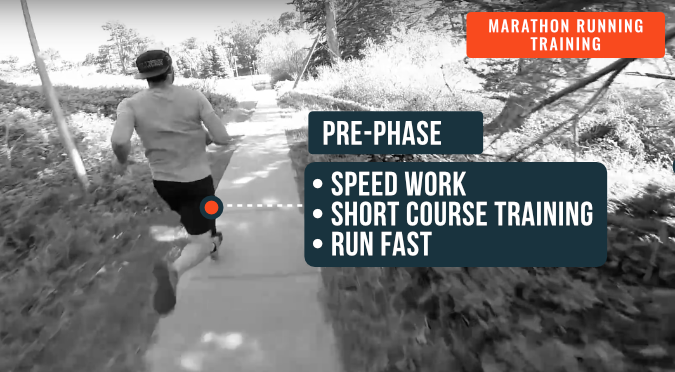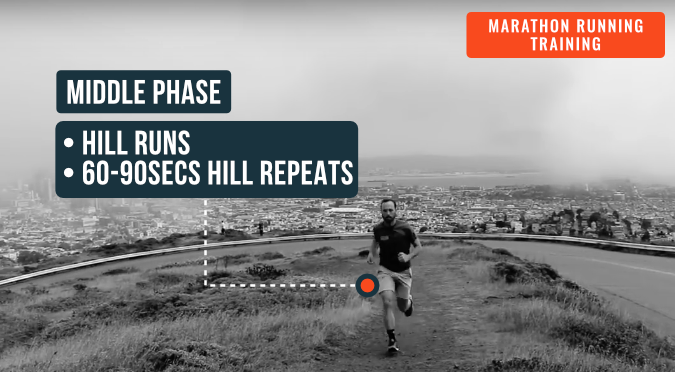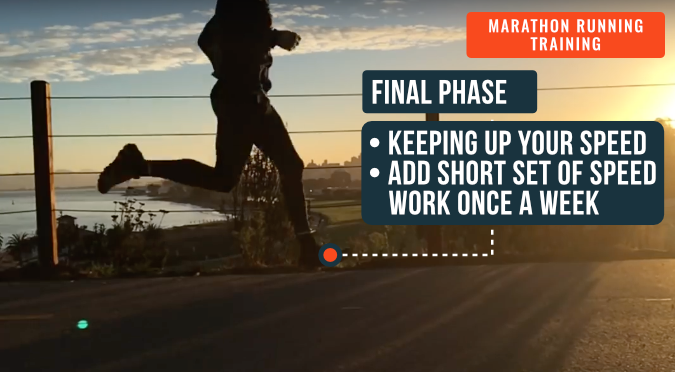How to Avoid the Running Plateau (Especially the Marathon Plateau)

Do anything for 16+ weeks straight of training and you might hit a wall. Marathon (and half marathon) training is no exception! Prevent your training from getting stale and stagnant by mixing up your training to avoid a running plateau (especially a marathon plateau).
How to Avoid a Running Plateau

In general, marathon training programs require a ton of dedication and effort. Marathoners put in week after week of running, strength training, and mobility work. Not to mention, you have to keep your nutrition on point and squeeze in plenty of sleep!
Mixing up your training with a variety of stimuli within those weeks will work wonders for keeping you sharp, injury-free, and constantly improving.
Now, let’s dig into the 3 phases of your training plan!
Phase 1: Pre-Phase

One of the most important factors in your marathon training schedule is how you’re spending your time BEFORE the official training plan kicks off!
To start, we usually hear how important it is to build a good endurance base, especially if you’re preparing for your first marathon. This is true, but you’ll be getting in A LOT of long endurance runs in the next few months. Spending some extra time now to work on your speed will pay off later in your training cycle.
Knowing this, it’s IMPORTANT that you spend some of your “off-season” running fast and short!
Here are a few training tips:
- You can follow a speed progression using a track or measured course. Spend 4-8 weeks decreasing your 1-mile, 2-mile and 5K times.
- Practice shorter training runs. Sign up for a few 5Ks to practice fast racing, chat with other runners, and soothe any jitters associated with a starting line.
- Incorporate cross training activities, such as swimming, biking or strength training.
Phase 2: Middle-Phase
You’ve officially started your marathon running training. The plan is in full force!
While still early in your training cycle, make sure you’ve read up on what your race course will look like.
For example, if your course is very hilly, don’t just train on the flat city streets. Make sure you’re getting some elevation gain on your long runs.
That might mean you have to “create” hills for yourself. The treadmill, stairs, and bridges make great substitutes.
Running a downhill course? Be sure to find a route that you can use to train your quads for the descent.
Since we’re trying to avoid a training plateau, don’t forget to change up the location of your long distance run if possible. Avoid always running the same course week over your weeks of training to help keep your body guessing.
Now, let’s take a look at what the early-middle phase of your marathon running training should include.

Hill sprints can help bust a training plateau in the following ways:
- They’re a perfect way to introduce speed work into your training if you’ve never tried it before.
- They require short strides, which give your hamstrings a break.
- Hill sprints take some pounding off of your legs.
- They offer the opportunity to get off the road.
- You can use hill repeats as a warm-up or standalone workout!
Depending on how you’re using them in your training plan, we recommend accumulating 5-10 hill repeats. Each repeat should be 30-60 seconds of uphill effort before the recovery jog or walk downhill.
These are an awesome alternative to a long, slow, easy-breathing run.
Phase 3: Final Phase

Above all, the way to avoid the marathon plateau is by breaking up your long, moderately-paced marathon running training with SPEED!
In the final phase of your marathon training plan (perhaps the 4-6 weeks leading up to the race day) you should sprinkle in speed work that affects the body from a neuromuscular perspective.
Unlike the hill sprints or 5K track workouts, this kind of speed work is specifically designed to get the muscles reacclimated to “running fast.”
At this point, you’re probably a little burnt out. You’ve spent the last three months getting in your weekend long run. You’ve rotated through the same few tempo workouts for weeks.
This kind of speed work is fun, quick, and only needs to be incorporated once a week, preferably at the end of a tempo or long run!
Here’s what you’ll do:
- Find an empty soccer or football field, if you have access to one.
- Take off your running shoes.
- Start running at a 5K pace (with your best running form) and gradually speed up to a shorter, quicker sprint, accumulating 50-100 meters.
- At the end of your sprint (50-100 meters), you’ll slow down into a walk or jog for what would be equivalent to the length of three or four of your sprints.
Keep in mind, this kind of speed work isn’t going to take it out of you in the way your hill sprints will. But, it will improve your running form and cadence.
It will also help build that neuromuscular connection that tells the body “Hey, this is what running fast feels like.”
Tips to Avoid the Marathon Plateau
Sleep
This one may seem so obvious, but it’s also so easy to overlook! Marathon runners are putting in week after week of solid training and high weekly mileage, and your body is going to feel the effects!
If you can manage it, see if you can jump in bed a little earlier on those weekend nights to help your body recover from the long run effort. Some extra Z’s after a speed session will also help you feel ready to go for the next workout session.
Nutrition
Don’t let your nutrition plateau, either! Try a new recipe each week, add a new supplement to your smoothie, or keep track of how many glasses of water you actually drank (not just planned to drink). For longer runs, you can supplement with a sports drink to regain electrolytes.
Mobility
Get on a roller or lacrosse ball! Especially after a hill or speed session, give your body some recovery love with at least 10 minutes of mobility work. This will help prevent cramps and tightness, as well as promote blood flow to the area to help with recovery. After a long run, some shoulder mobility might be just the ticket.
Don’t have any mobility tools? No worries! Just getting into a quality cool-down routine will help prevent soreness for your next training session.
______________________________________________________________________________
Break your marathon running training up into these three phases, adjust your speed training as recommended, and you can easily avoid the marathon training plateau and CRUSH your next race!
Keep Your Running Fresh
Want to avoid running plateaus for the long term? Follow a training guide and plan. Download and enjoy our free, COMPREHENSIVE marathon training guide. We carefully put this together, to steer you in the right direction for your next race! Get it HERE!
